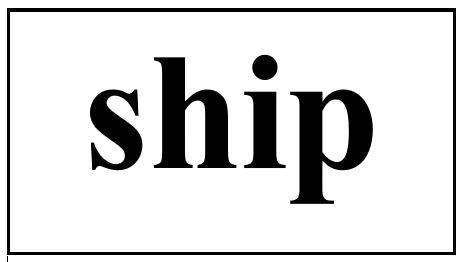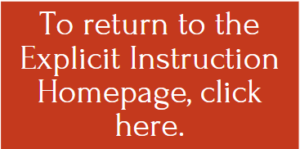Explicit Instruction Case Study Part Three

In the second part of the case study, we saw how Mrs. Adams used the elements of explicit instruction. Let’s review what she did:
Element #9 – Mrs. Adams provided her students with a range of examples and non-examples for the digraph “sh.”
Element #14 – Mrs. Adams is delivering her lesson at a brisk pace to maximize instructional time and decrease students time off task.
Let’s see how Mrs. Adams continues her lesson with the elements of explicit instruction.
“Now that we have seen some examples and non-examples of the digraph “sh,” let’s do some practice. I am going to show you a card with a word on it. You are going to decide if this word is an example or a non-example. When I say “everyone,” you are either going to put a thumbs up for example or a thumbs down for a non-example.”
“Let’s practice the signal with the word card “ship.” (Presents students with the word card “ship.”)

“Remember, if this is an example it’s a thumbs up and if it is a non-example, then it’s a thumbs down. Here we go…everyone (allows wait time) – everyone puts their thumbs up. Great job guys. This is an example of a word with the digraph “sh.”
“Now let’s get started with our practice. Remember that you have your “digraph sh” card to help you while you decide if the word is an example or non-example. Here we go!”
Is this word an example of a word with the digraph “sh” in it? (Presents students with the word card for “shot.”)

“Think about it. (allows for wait time) Everyone – (everyone gives a thumbs up). Very good, this is an example of a word with the digraph “sh.” Can everyone point to the digraph “sh” on the card? Everyone – (everyone points to “sh” on the card).
“Great job everyone. I like how you are using the correct signals when answering the question. Let’s practice another one.”
“Let’s look at this word.” (Presents students with the word card “slot.”)

“Is this an example of a word with “sh” in it? Think about it. (allows for wait time) Everyone” – (Joey and Oscar give a thumbs down but Jordyn gives a thumbs up).
“Let’s look at this one. In this word, there is only the letter “s”. Give me a thumbs up or a thumbs down if you see the letter “h.” Everyone” – (everyone gives a thumbs down). Very good, there is no “h” in the word “slot.” Let’s practice this one again. Is this an example of a word with “sh” in it? Think about it. (allows for wait time) Everyone – (everyone gives a thumbs down). Excellent, this is not an example of a word with “sh” in it.
Mrs. Adams continues to practice with the students with the words “shoot,” “slate,” “house,” and “shock.” During this time, the students all get signals correct. Mrs. Adams has monitored the students performance during the guided practice. She has determined that the students are ready for individual practice.

Let’s break down Mrs. Adam’s lesson introduction and identify which of the elements of explicit instruction that she used.
Mrs. Adams is provided her students with multiple opportunities for guided practice with words that do and do not contain “sh.” (Element #10)
She is monitoring the students performance closely to see if students are ready for independent practice with the skill. (Element #12)
Let’s visit Case Study Part 4 to see how Mrs. Adams wraps up her lesson using the elements of explicit instruction.
Click on the image below to see Case Study Part 4.
References:
Archer, A. L., & Hughes, C. A. (2011). Explicit instruction: Effective and efficient teaching. New York: Guilford Press.

